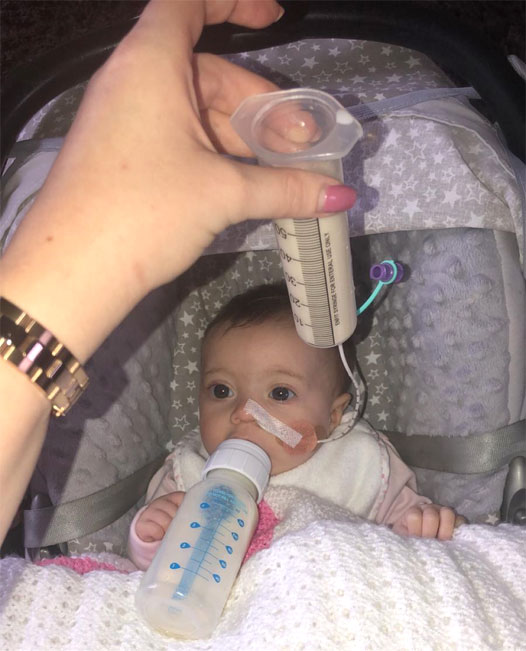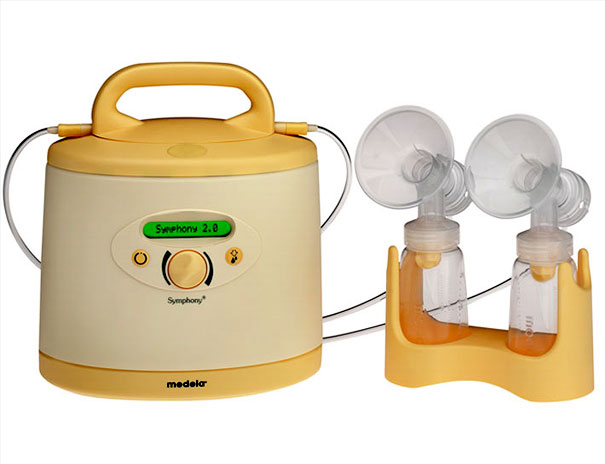My baby has PRS-What next?
3. Feeding
The breathing issues experienced by babies with PRS impact on their ability to feed orally from the breast or a bottle which parents can find difficult. Many parents express that they feel guilty and/or disappointed as they had been looking forward to feeding their baby.
Many babies with PRS will need to be fed via a feeding tube or part bottle part feeding tube. Understanding the reasons why your baby cannot feed orally may help you to cope and adjust for the time that this type of feeding is needed.
High energy infant formula is often prescribed for your baby to increase the amount of calories at each feed. This is because PRS results in more calories being used for breathing.
Select each title to find out more:
Select to hear the audio
PRS babies tire very easily from the effort of breathing, which in turn affects their energy levels to feed. The more tired the baby becomes, the less control they have over their tongue which can then rest far back in the mouth. If you put your tongue up and towards the back of your mouth you feel that swallowing is difficult.
Even for those babies who experience only mild breathing problems, the gap in the palate effects the ability to create a vacuum to suck milk from a bottle or the breast. It can be compared to trying to drink a milk through a straw with a hole in it. You would suck very hard just to get a small amount of fluid through the straw and get tired. Babies with a cleft palate can feed through a bottle that is soft to squeeze or a bottle with a special valve in the teat if assessed safe to do so.

Select to hear the audio
A nasogastric tube is inserted via the nose down the oesophagus (food pipe) and into the stomach. Milk is then put down the tube to feed your baby. It can also be used to give your baby medicine.
Parents are taught by the nursing staff in the hospital to insert and feed with the tube. Don't worry, this is done gradually and at your own speed.
Nasogastric tube
Oesophagus
Stomach

Select to hear the audio
Breast milk can be expressed using an electric breast pump and then stored and given to your baby. This is considered the Gold Standard for babies with a cleft palate. The nursing staff in the hospital will support you with this and once you get home community nursing staff. If you wish to give your baby expressed breast milk then please let the nursing staff know as soon as possible. The cleft team will inform you about acquiring a breast pump to use at home.
Using the breast pump frequently (8-10 times a day) will help to get the milk supply established.

Listen Vicky Stainsby a Consultant Nurse Specialist share her experience
Karine: Feeding assessments are a core part of the care for babies with Pierre Robin Sequence, as a clinical nurse specialist can you explain why they are important?
Vicky: So really important for the baby in terms of safety, we need to ensure that breathing is not compromised in the first instance before we think about a feeding assessment. So, safety, the infant experience, we want it to be a pleasurable experience for the infant, it’s really about the quality of the experience and not about the quantity of milk taken, or how long the feed takes. We also want it to be a really positive experience for both parties, for the person doing the feed and for the baby as well and the feeding assessment is something that can be carried out whenever there is a change in babies condition, if breathing changed at all, we would continue at looking at what is working for the baby and assess accordingly.
Karine: Following on from that can you explain what happens during a feeding assessment for us please?
Vicky: So during the feeding assessment we would want to be there at the time of the babies feed, we would want them to be awake and alert and receptive and willing to feed. We would want to make sure they had some spontaneous mouth opening, we’d perhaps want to see their rooting reflex by gently touching their lips, we’d also want to see how regular their sucking pattern would be, either with use of a pacifier or just by sucking on a clean gloved finger, we then would also ensure the gag reflex is positive by inserting the finger a little bit further into the mouth and just making sure the baby had that cough reflex which is a protective mechanism for their airway. Having done all that we would settle the baby into a side lying position with head elevated and that would just be to give them a little more pacing time with the feed, so that if they were over whelmed with milk or took a little bit too much the milk could pool in their cheek rather than sort of hitting the back of their oropharynx and startling the baby.
So nice side lying position, a small amount in the bottle to start with and a very tentative approach watching carefully for the suck, swallow, breathe, pattern of coordination, just to ensure there is no compromise at all the that babies breathing, if there were any changes like that we would stop that feeding assessment and we would continue then to reassess at a different time, so we would continue to offer non-nutritive sucking via dummy, pacifier, or gloved finger to keep those oral skills going, before we then look again at repeating a feeding assessment.
So feeding assessments could be repeated again fairly frequently, it’s very individual to each baby, if there was any change to babies condition, if babies airway needed any alteration, if they had a nasal pharyngeal airway that was removed, if their breathing worsened, those are the sort of times we would consider doing another assessment just to make sure that safety is still there for that baby, so they can range in time from anywhere between two to three weeks up to sort of six months really.
- Try to keep your baby close to you at feeding times
- If you are feeding via a feeding tube then ask about a feeding pump for when you go home as this frees up your hands to hold your baby